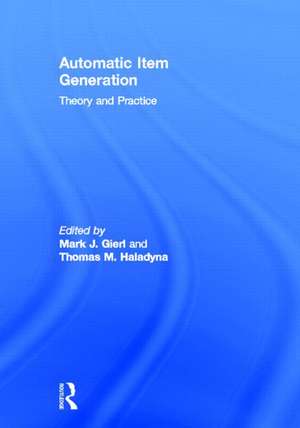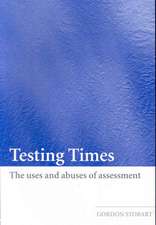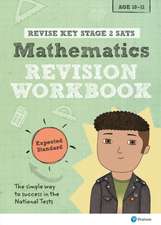Automatic Item Generation: Theory and Practice
Editat de Mark J. Gierl, Thomas M. Haladynaen Limba Engleză Hardback – 7 aug 2012
Comprehensive – The book provides a comprehensive analysis of both the theoretical concepts that define automatic item generation and the practical considerations required to implement these concepts.
Varied Applications – Readers are provided with novel applications in diverse content areas (e.g., science and reading comprehension) that range across all educational levels – elementary through university.
| Toate formatele și edițiile | Preț | Express |
|---|---|---|
| Paperback (1) | 528.54 lei 6-8 săpt. | |
| Taylor & Francis – 7 aug 2012 | 528.54 lei 6-8 săpt. | |
| Hardback (1) | 1278.70 lei 6-8 săpt. | |
| Taylor & Francis – 7 aug 2012 | 1278.70 lei 6-8 săpt. |
Preț: 1278.70 lei
Preț vechi: 1559.39 lei
-18% Nou
Puncte Express: 1918
Preț estimativ în valută:
244.68€ • 256.11$ • 203.65£
244.68€ • 256.11$ • 203.65£
Carte tipărită la comandă
Livrare economică 01-15 aprilie
Preluare comenzi: 021 569.72.76
Specificații
ISBN-13: 9780415897501
ISBN-10: 0415897505
Pagini: 256
Ilustrații: Following SEtting Performance Stds - tight template
Dimensiuni: 178 x 254 x 16 mm
Greutate: 0.63 kg
Ediția:1
Editura: Taylor & Francis
Colecția Routledge
Locul publicării:Oxford, United Kingdom
ISBN-10: 0415897505
Pagini: 256
Ilustrații: Following SEtting Performance Stds - tight template
Dimensiuni: 178 x 254 x 16 mm
Greutate: 0.63 kg
Ediția:1
Editura: Taylor & Francis
Colecția Routledge
Locul publicării:Oxford, United Kingdom
Cuprins
Part I. Initial Considerations for Automatic Item Generation 1. Automatic Item Generation: An Introduction Mark J. Gierl and Thomas M. Haladyna 2. Automatic Item Generation: A Historical Perspective Thomas M. Haladyna 3. Using Weak and Strong Theory to Create Item Models for Automatic Item Generation: Some Practical Guidelines with Examples Mark J. Gierl and Hollis Lai 4. Item generation: Implications for a validity argument Isaac I. Bejar Part II. Connecting Theory and Practice in Automatic Item Generation 5. An Introduction to Assessment Engineering for Automatic Item Generation Richard M. Luecht 6. Generating Items under the Assessment Engineering Framework Hollis Lai and Mark J. Gierl 7. Using Evidence-Centered Design Task Models In Automatic Item Generation Kristen Huff, Cecilia B. Alves, James Pellegrino and Pamela Kaliski Part III. Psychological Foundations for Automatic Item Generation 8. Learning Sciences, Cognitive Models, and Automatic Item Generation Jacqueline P. Leighton 9. Using Cognitive Psychology to Generate Items and Predict Item Characteristics Joanna S. Gorin 10. Difficulty Modeling and Automatic Generation of Quantitative Items: Recent Advances and Possible Next Steps Edith Aurora Graf and James H. Fife Part IV. Technical Developments in Automatic Item Generation 11. Statistical Modeling of Automatically Generated Items Sandip Sinharay and Matthew S. Johnson 12. Automatic Item Generation for Computerized Adaptive Testing Richard M. Luecht 13.IGOR: a Web-Based Automatic Item Generation Tool Todd Mortimer, Eleni Stroulia, and Meisam Vosoughpour Yazdchi 14. Obstacles for Automatic Item Generation Thomas M. Haladyna and Mark J. Gierl
Notă biografică
Mark J. Gierl is Professor of Educational Psychology and Director of the Centre for Research in Applied Measurement and Evaluation in the Department of Educational Psychology, Faculty of Education, at the University of Alberta. He holds the Canada Research Chair in Educational Measurement.
Thomas M. Haladyna is Professor Emeritus, Arizona State University. He is the author of numerous books in the field of educational assessment and test item development, including the much praised Handbook of Test Development.
Thomas M. Haladyna is Professor Emeritus, Arizona State University. He is the author of numerous books in the field of educational assessment and test item development, including the much praised Handbook of Test Development.
Descriere
The purpose of this book is to bring researchers and practitioners up-to-date on the growing body of research on Automatic Item Generation by organizing in one volume what is currently known about this research area.














